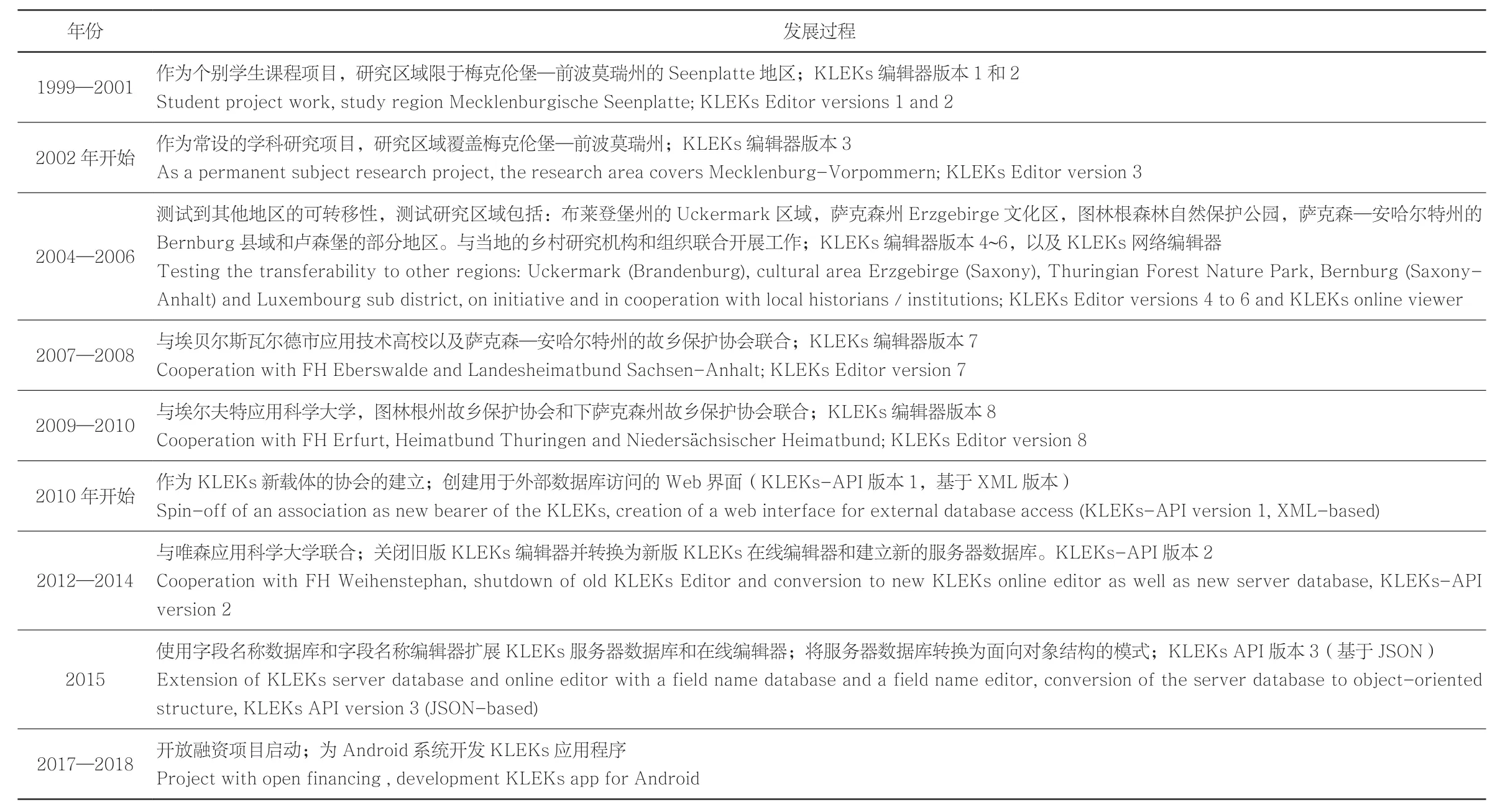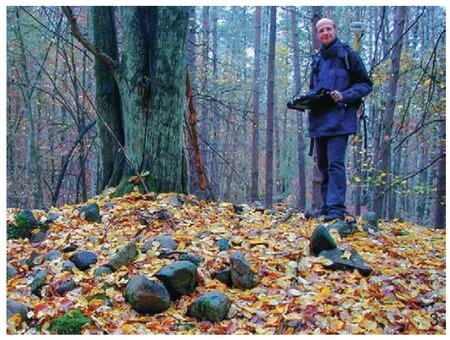20年的“KLEKs”—德国基于志愿参与的历史性文化景观要素数据库的建立
2019-12-03迈克施托克曼伊尔可马绍尔孔洞一
著:(德)迈克·施托克曼(德)伊尔可·马绍尔 译:孔洞一
在经济、社会和文化发展过程中,往往有一些并不那么明显的景观要素细节,使得景观呈现出它们各自不同的“面孔”。比如,泥灰岩洞穴、冰窖、石铺街、纪念石、石砌墙或头形树等①(图1)。《德国国家自然保护法》②、《德国国家空间规划法》③以及各个州的相关法规,都规定了对“历史性文化景观”的保护[1]。而现实中的情况往往是随着道路修建、居住区拓展、土地整合和土地利用性质变更等建造活动,越来越多的历史性文化景观要素正在消亡。造成这样情况的原因很多,而对这些文化景观要素的认知缺失和价值评判失误是其重要原因之一。特别是在乡村地区,历史性物质要素的消亡可能引起景观多样性和特性的丧失,从而使得景观的可识别性显著降低。
2000年的欧盟部长会议通过了《欧洲景观公约》,并将其作为成员国的签字协议而执行。《欧洲景观公约》采用整体思考方法,将景观理解为人类栖息地的一部分,表达其作为文化和自然遗产二者统一的多样性,并且以此新景观概念的定义作为区域风貌的可识别性的理论基础。而这一界定,使得景观的概念,在某些方面与德国普遍实行的自然保护实践发生了冲突。后者只专注于实现生态目标,而往往忽略了景观的文化历史维度。而“历史性文化景观”的概念,则符合《欧洲景观公约》所要求的一个整体的景观保护目标,即综合考虑自然、历史、文化和生态等因素,来评价景观状态和潜力的要求[2]。

1 图林根特色文化景观元素举例An example of a cultural landscape element in Thuringia1-1 魏玛市Niedergrunstedt区的地窖Cellar in Niedergrunstedt District, Weimar City1-2 Frienstedt的馒头柳Pollarded willows in Frienstedt

2 KLEKs编辑器2005版本主界面Main interface of the KLEKs Editor version 2005
1 文化景观要素收集系统“KLEKs”的创建和发展过程
对景观的历史文化维度方面的分析研究,有很多途径。历史性文化景观要素的概念,为景观的现状表述、价值评估和规划实践提供了良好的可操作方式。目前在德国也存在多种与之相对应的分类和收集体系。其中,最全面的历史性文化景观要素数据系统之一是“KLEKs”。它拥有迄今超过30万的文化景观要素数据库。
KLEKs系统最初是1999年在新勃兰登堡应用科学大学的景观保护专业的教学项目中开始建立的(表1)。当时的背景是:1997年开始的德国梅克伦堡—前波莫瑞州的国家支持的乡村联盟“就业创新项目”中,需要对众多的县乡范围的历史性文化景观要素进行收集和归档的工作。其专业方面的技术支持,是由新勃兰登堡应用科学大学的师生们承担的。在此之前的几年中,遗产协会“Landesheimatverband”以纸质文件记录了各种历史元素,遵循Wöbse提供的方法。当时的数据还都是采用软盘或者CD-Rom来储存的。其中KLEKs系统编辑器作为Windows 98/XP桌面应用程序的第一次编程,是由Maik Stöckmann先生完成。而第一批KLEKs数据集,最终也作为学生学期项目成果来展现。同时,KLEKs编辑器也被提供给对此感兴趣的乡村研究者。他们使用手头收集的数据,如众多里程碑或老磨坊的位置、信息和图片等,来利用编辑器自助登记(图2)。他们当中的一些乡土历史专家,往往对当地的历史性文化景观要素有广泛而深刻的认知。对这些乡土专家所提供知识的登记也是非常重要的。到了2000年的时候,梅克伦堡—前波莫瑞州境内已经有大概6 000个文化景观要素在数据库里被登入。接着,KLEKs系统也逐渐地向着德国其他的州和地区推广扩展。2004年,KLEKs系统收录了超过2万个要素信息。2009年,系统的数据库存量已突破了19万个文化景观要素信息,其中包含大约1.5万个简述性文稿和3万张照片(图3)。
2 研究方法
KLEKs概念的出发点,最初是根据Wöbse在1997年所倡议的“建立景观要素登记表”的想法而发展起来的。Wöbse希望对于一些特别的景观要素的收集进行规范化界定[3]。这些要素既不严格属于自然保护的范畴,也不完全属于文化遗产保护的范畴。而事实证明,这个想法在实践中难以实现,原因有2个。1)自然保护与文化遗产保护自身并没有明确地界定哪些种类的要素与之相关。例如,散生石,在梅克伦堡—前波莫瑞州的自然保护法规里规定,只有当其表面覆盖了自然原生植被的情况下,才算作保护要素,而无视其可能存在的古老的历史文化价值。在梅克伦堡—前波莫瑞州,工业时代以前的“木炭窑址”也没有系统性的收集,只有当它十分特别或者和古老的考古发现相关的时候才会被注意到。2)许多项目参与者也将他们的观察与对整个文化景观的历史增长结构的探索联系起来,以探求对文化景观的整体有更好的理解。所以,局限的“抽屉里的想法”(德语谚语,不开放的思维)是没有效果的。为了能够描绘和研究历史性文化景观要素的关系结构,有必要拓展方法论,不仅包括Wöbse所列出的景观元素类型,还应包括建筑和自然遗迹、地质元素以及今天不再存在的景观特征和景观元素(图4)。

表1 KLEKs系统发展的时间过程Tab.1 Chronology of the development of KLEKs system
在KLEKs框架下,基于功能领域划分的景观要素类型发展起来。下面是一个历史性文化景观要素“Galgenberg”的数据登记表,它被上面所说的功能类型划分为“权力政治”类(图5)。
长期以来,KLEKs的几个合作伙伴一直在寻求对系统的优化。其中最重要的是“致力于开发适用于整个德国的统一标准的分类规则和具有移动终端功能的登录系统”[4]。虽然,目前该计划因缺乏必要的资金而进展缓慢,但KLEKs一直在探索使用更加优化的系统和分类标准。
3 KLEKs编辑器和KLEKs数据库
除了Windows应用程序的KLEKs编辑器之外,KLEKs还特别支持一个可网络编辑的中央地理数据库,并同时拥有这个网络编辑器的本地数据库副本。人们可以利用这个网络编辑器执行离线数据录入,即使在田野调查中使用GPS终端输入也是可以的。新的信息记录会自动与服务器数据库同步更新。KLEKs编辑器将专业地理信息系统的优势与普通桌面应用程序的简单性相结合,而无须用户熟悉复杂的专业程序。任何人都可以在很短的时间内轻松找到应用程序并使用它。交互式地图可以搭建起用户与信息系统之间的图形界面。文化景观要素可以通过点、线和面的空间形态被表现出来。这样的几何图形(点线面)信息会被链接到专题信息库。基于互联网,地图中的要素显示为一种超链接形态,并可附加描述性文本和其他的信息。可根据内容、空间、时间等维度来排列(所录入的)元素信息。
信息库清单包含3个相关的信息级别:
1)具有地理形态和基本数据的核心数据库。例如(景观)类型和(历史)年代。
2)具体的不同专业视角的信息数据、评价标准、登记表格等。
3)包含文本和照片的HTML文件。该项目主要用于环境教育和旅游规划[5]。
基于软件开发框架VisualBasic 6而发展出来的KLEKs 2014编辑器,不再完全兼容目前的Windows 8/10操作系统,因而必须被淘汰。于是,目前只有KLEKs-Online网络编辑器可用(图6)。而对于Android系统的KLEKs应用程序计划的新研发成果,能够保障KLEKs在田野调查中现场离线使用。但遗憾的是目前这项研发项目没有找到足够的资金支持。

3 利用专业GPS仪器在田野里收集文化景观数据Collect cultural landscape data in the fields with a professional GPS device
4 KLEKs在规划上的应用
将历史性文化景观在城市和区域规划实践应用中的困难,主要存在于:历史性文化景观要素的收集、评估及其规划应用过程是一个花费巨大且非常耗时间的过程。此外,对规划区域、信息来源和文献研究的反复检查,也超出了常规紧张的规划时间。对文化景观要素的评估需要对规划区域的自然和历史特征有新的认识。同时,通常可用的官方数据中存在不充分和缺失的信息。而KLEKs则可以帮助建立一个把自然和文化古迹的官方数据与社会和公民科学家的集合结合起来的数据系统,从而最大限度地降低景观规划的数据采集成本。从这个意义上,KLEKs从一开始就被设计为数据库和操作工具。不幸的是,到目前为止,KLEKs还没有持续的融资。由于迄今为止很少得到国家支持,并且也缺乏必要的财政支持,使得数据库目前尚未健全。
而“文化遗产”与新的欧盟环境影响评估指标,都在《欧盟遗产保护法》里有所体现。根据该法令第三款第1条d项,“特征实体,文化遗产和景观是必须作为影响特定保护项目的直接和间接因素而被彻底评估”。这里的“文化遗产”评估,也是指针对环境的影响评估衍生的工具和程序[6]。
5 KLEKs在图林根州的应用和现状
然而,历史性文化景观要素的数据库目前仍然主要是基于“志愿参与”的项目来收集的。在KLEKs框架内的高校教学项目也是“志愿参与”的一种形式。目前包括图林根州在内的德国各个州的KLEKs项目也都是如此。在高校教学项目下,可以根据学生和研究者的兴趣,在一定的主题下,来对一些小范围的文化景观要素集群和类型进行研究(图7)。
KLEKs系统的应用的一个重要项目是:在埃尔夫特应用科学大学景观专业的教学课程计划支持下建设的“图林根文化景观网站”④。在本科阶段的课程里,就已经设置了KLEKs系统的介绍。在硕士阶段,学生定期对某个主题下的研究区域内的要素,进行采集和绘图工作。最终的期末成果,学生会在KLEKs数据库的管理员的辅导下,以标准化的格式将信息录入到系统中。硕士课程阶段,又有更加深入的关于文化景观要素的价值评估和其规划应用方面的内容。例如,文化景观游憩道路规划或者文化景观标识牌设计。因此,KLEKs系统的应用,目前已经是埃尔夫特应用科学大学的景观规划学科必不可少的教学内容之一。
6 总结
就像维基百科一样,KLEKs是一个基于GIS平台的地理信息收集的查询工具和数据库。所有的人,包括每个公民、研究人员和规划师都可以同样地享有它的使用权利。与德国其他州的同类数据库(例如北莱茵—威斯特法伦州的KuLaDig或下萨克森州的ADABweb)相比,它并非专门为政府和官方设计的数据库。它的信息来源也非常多样化,例如有来自文化遗产名录的清单,有来自当地历史学家、乡村协会的资料档案,也有来自规划设计事务所的信息。各种历史性文化景观要素的信息、文字和图片等相关数据都可以作为收集和录入对象。实时的数据库也可以被修改和补充。因此,一个完成的历史性文化景观要素信息的建立可能是一种社会协助过程:当地的一位历史学家在数字地图上标注了一个新的文化景观要素,而一位博物馆工作人员来补充这个要素的背景文本描述,然后景观规划事务所的人员来添加实地调研中拍摄的照片,并根据设计标准来评估要素。通过KLEKs,可以实现全面而完整的历史性文化景观要素数据库的建立。它通过广泛的潜在社会协同来节约成本,并允许通过网络公共访问来不断增长和改进数据信息⑤。同时,KLEKs数据库支持每个数据字段的多语言分隔条目,并且所有使用的术语以英语并行存储。然而,应该强调的是,造成KLEKs如此规模的决定性因素是网络普及和迄今为止的大量志愿者的参与。而目前在德国的政府资助下的历史性文化景观收集数据库项目,以及相关有公共资助的数据维护,也只有在大学这样的机构里可以生存。
注释:
① 泥灰岩洞穴、冰窖、石铺街、纪念石、石砌墙或头形树是几种德国中部典型的文化景观要素(译者注)。
② 《德国国家自然保护法》,德文:Das deutsche Bundesnaturschutzgesetz。
③ 《德国国家空间规划法》,德文:Das Bundesraumordnungsgesetz。
④ 引自 http://www.kulturlandschaft.fh-erfurt。
⑤ 引自 https://www.kleks.app/。
⑥ 图1来自伊尔可 马绍尔,图2来自KLEKs网站,图3来自Roland Weber,图4、6来自迈克 施托克曼,图5来自KLEKs编辑器2010版,图7来自图林根州报的Frank Karmeyer;表1来自迈克 施托克曼。
(编辑/刘玉霞)

4 所收集数据的科学化重组Scientific reorganization of collected data

5 KLEKs编辑器要素表,2010年登入Element form of the KLEKs Editor, accessed in 2010
The inconspicuous evidence of economic,social and cultural development—such as marl pits,ice cellars, cobblestone streets, memorial stones,rock walls or head trees①—often give landscapes their true identity (Fig.1).The German Federal Nature Conservation Act②, the Federal Spatial Planning Act③and the laws of the federal states provide for the protection of historically evolved cultural landscapes[1].In practice, this often fails.Most of the historic cultural landscape elements are disappearing due to urban sprawl in the form of traffic infrastructure, settlement expansion, land consolidation and change of land use patterns.There are many reasons that play a major role in the lack of the appreciation of such elements.Particularly in rural regions, the loss of historical substance can significantly reduce the diversity and peculiarity of the landscape.
The Committee of Ministers of the Council of Europe adopted the European Landscape Convention (ELC) in 2000 and opened it for signature by the member states.The ELC takes a holistic approach and understands landscapes as part of the human habitat, as an expression of a diversity of their common cultural and natural heritage and as the basis of their identity.This is partly contrary to nature protection practice in Germany that is focusing on the implementation of ecological goals and often neglecting the cultural-historic dimension of the landscape.The protection of historic, cultural landscapes responds to the goals of an integrated landscape protection strategy.Therefore, the protection measures as required by ELC consider and evaluate the potentials of a landscape on the basis of its natural,historical, cultural and ecological characteristics[2].
1 Beginnings and chronological development of the cultural landscape element cadastre KLEKs
There are various approaches to the historicalcultural dimension of the landscape that represents a more or less operable way for stocktaking, evaluation,and planning process.However, there are only a handful of approaches to digital data collection.The most comprehensive of all the inventory is “KLEKs” which has over 300,000 recorded information about the cultural landscape elements that are present in the country.Subsequently, the database was introduced with the foundation stone laid in 1999, coincidently in a student project at the University of Applied Sciences Neubrandenburg(the acronym KLEKs stands for “Kulturlandschaft selementekataster”—in English “Cultural landscape element cadastre”).In the years before, various historical elements were documented by the heritage society “Landesheimatverband” in paper-based files following the methodology provided by Wöbse[3].The University was asked for support and guidance.As a result, the first “KLEKs Editor” was developed and introduced by student Maik Stöckmann as a desktop application for Windows 98/XP.The data collation was done by floppy disk and CD-Rom.
Consequently, the first KLEKs datasets were created as part of a student project assignment (Tab.1).Simultaneously, the database was also made available to interested local researchers and associations to integrate their knowledge by entering more records, for example,mill sites, milestones etc (Fig.2).The citizen scientists often have knowledge about specific historic landscape elements.As local experts, they are of great importance for the collation of cadastre data.
Almost 6,000 cultural landscape elements were entered in the database by the year 2000,primarily for the federal state of Mecklenburg/Western Pomerania.In the following period, the KLEKs application was extended to other federal states and regions in Germany.Finally, by the year 2004, the KLEKs database contained more than 20,000 elements and by early 2009 had over 190,000 landscape features, about 15,000 further descriptive texts and 30,000 photos (Fig.3).

6 组件和数据流Components and data flow

7 埃尔夫特应用科技大学开放日上的KLEKs应用演示,2018KLEKs application presentation in the Open Day of University of Applied Sciences in Erfurt, 2018
2 Collection methodology
The inception of the KLEKs was initially the methodical proposal of a paper-based element mapping form propagated by Wöbse[3].Wöbse wanted to limit the collection to objects, which were previously neither protected by natural means of conservation nor by the preservation of monuments.This methodology proved to be a difficult task to implement in practice for a couple of reasons.Likewise, nature conservationist and monument preservationists had no clarity about the objects relevant to them.Thus, for example,according to the nature conservation law in Mecklenburg/Western Pomerania, stone cairns and bars are only protected if they belong to the natural field hedges, regardless of their possibly age-related cultural-historical value.Pre- and early industrial charcoal kiln sites are not systematically recorded by the archaeological authority unless they are related to older archaeological finds.
Simultaneously, there are many actors involved to explore the historically grown structure of the cultural landscape in a more holistic dimension.In order to characterize and investigate the interactions between cultural-historical landscape elements, it became necessary to expand the methodology.Further, it includes the landscape elements as listed by Wöbse and also incorporates the existing architectural and natural monuments.The list also features past elements that no longer exist today.The possible fields of application have been extended, compared to Wöbse’s list so that scientific and planning questions can be timely answered (Fig.4).
As part of the KLEKs, a typology of landscape elements was developed, structured according to function-based topics.Thus, a historical“Gallow place” as in the example below is assigned to the function type (“Place of execution”, Fig.5).
The collaboration of associate partners of KLEKs made it necessary to constantly extend the typology.The pragmatic addition of terms over the years resulted in a cluttered grown system that has to be optimized.Therefore, a project was planned, to standardize the overall system of historic landscape element data collection and typology throughout Germany[4].Unfortunately, it was not possible to acquire the necessary funding.Therefore, a very pragmatic and certainly further optimizing typology will continue to be used.
3 KLEKs database and KLEKs Editor
KLEKs consists of a central server-based geodatabase with an Internet-based communication interface called “KLEKs API”.It is built upon LINUX, Apache, PHP and PostgreSQL/PostGIS,where JSON datatypes are extensively used as a supplement to classic relational database structures.The KLEKs Editor uses the KLEKs API to download the object-oriented records from the server and set up a local copy of the central geodatabase.New or modified records are later uploaded to the server database.This allows of fline usages such as field surveys by pairing the KLEKs Editor with a GNSS receiver (Fig.3).The captured data is later automatically synchronized with the server database.Older versions of existing records are archived and can be restored if necessary.Possible conflicts are reported to the administrators.The KLEKs Editor, on the other hand, combines a professional geographic information system with an intuitive user interface.So the user can conveniently understand the application in a short period of time without a special course[5].
Since the KLEKs Editor was developed using“Visual Basic 6” hence the software development framework is no longer compatible with current Windows operating systems, the KLEKs Editor therefore had been shut down in 2014.Instead, the web-based KLEKs Online Editor was introduced.Unfortunately, the planned redevelopment of a KLEKs App could not be realized due to lack of funds, so of fline applications are currently not possible (Fig.6).
4 Use of KLEKs in planning process
There are difficulties to consider historical cultural landscape elements as an important aspect in the regional and municipal planning practice,especially because the collection and assessment of the data is a very expensive process.Moreover, the repeated inspections of the planning areas, sources and literature studies exceed the time available for urgent planning.The assessment of cultural landscape elements requires fresh knowledge about the natural and the historical character of the planning region.At the same time, there is inadequate and missing information in the usually available data.That’s why KLEKs can help to combine the official data of natural and cultural monuments with the collections of societies and citizen scientists and in this way minimize the data acquisition costs for landscape planning.
Unfortunately, until now there is no continuous financing for KLEKs.Above all “cultural heritage”is an important protective measure for EU law.The present EU Environmental Impact Assessment Directive in Article 3 (1) (d) elucidates “physical assets,cultural heritage, and landscape” as factors which have a direct and indirect significant impact on the project and hence must be thoroughly evaluated.This is an impact assessment derivative and procedure done for the environment[6].
5 Status and application of the KLEKs in Thuringia
It is important to note that many of these historical cultural landscape element data sets are currently compiled on a voluntary basis and are confined to student projects.Although, the framework of the KLEK is absolutely comprehensive for Thuringia region.Consequently, the volunteers and researchers of cultural landscape focus on specific topics and elements that are recognizable based on the knowledge and interests (Fig.7).
The KLEKs application is as well part of the cultural landscape education of the Bachelor and Master Degree program in Landscape Architecture at the University of Applied Sciences Erfurt④.In the Bachelor's course, the students are already introduced to cultural landscape analysis.During the Master program, students regularly map a certain section of an area,which is usually placed in a thematic context of mapping.The results are entered by the students in a qualified form with the help of supervisors in the KLEKs database.Furthermore, the projects done at Master level, serve to the valorization of selected elements and areas in the context of the development of “cultural landscape experience trails”, “information boards” etc.
However, the active use of the KLEKs has become an indispensable part of the education system of landscape architects in Erfurt.
6 Summary
Like Wikipedia, KLEKs is a database with GIS-based information and query tools.The system is equally usable by citizens, researchers,and planners.In contrast to other solutions in Germany (e.g.KuLaDig in North Rhine-Westphalia or ADABweb in Lower Saxony), it is not designed as an official database.It contains information from various sources, such as monument lists, local historians, associations and landscape planning of fices.The information is based on texts and photos of diverse historic cultural landscape elements.The records are stored object-oriented, existing data records can be modified, while older record versions are archived.That opens the possibility for a local historian to draw a new landscape element on the digital map, a museum employee to complete a description of the story, and a landscape planning office to add a photo taken in the field while doing surveys and also to evaluate the element according to the design criteria.With KLEKs a comprehensive and complete inventory of historical cultural landscape elements can be achieved.By taking advantage of the potential synergies and by saving costs, it allows access to an extensive, constantly growing and improved database⑤.It should be emphasized that the KLEKs database supports multi-language separated entries as per data field and all terms used are already stored simultaneously in English.
However, the critical factor of the network relies on the number of volunteers.Unfortunately,the funding for the mapping of historical cultural landscape elements, as well as publicly funded data maintenance by universities is not done yet.
Notes:
① Mergelgruben(marl pits), Eiskeller(ice cellars)und Kopfsteinpflasterstraßen(cobblestone streets),Gedenksteine(memorial stones), Lesesteinwälle oder Kopfbäume(rock walls or head trees).
② German: Das deutsche Bundesnaturschutzgesetz.
③ German: Das Bundesraumordnungsgesetz.
④ ©http://www.kulturlands·chaft.fh-erfurt.
⑤ ©https://www.kleks.app/.
⑥ Fig.1©Marschall, Fig.2©KLEKs website, Fig.3©Roland Weber, Fig.4, 6©Maik Stöckmann, Fig.5©KLEKs Editor 2010, Fig.7©Frank Karmeyer, TLZ; Tab.1©Maik Stöckmann.
